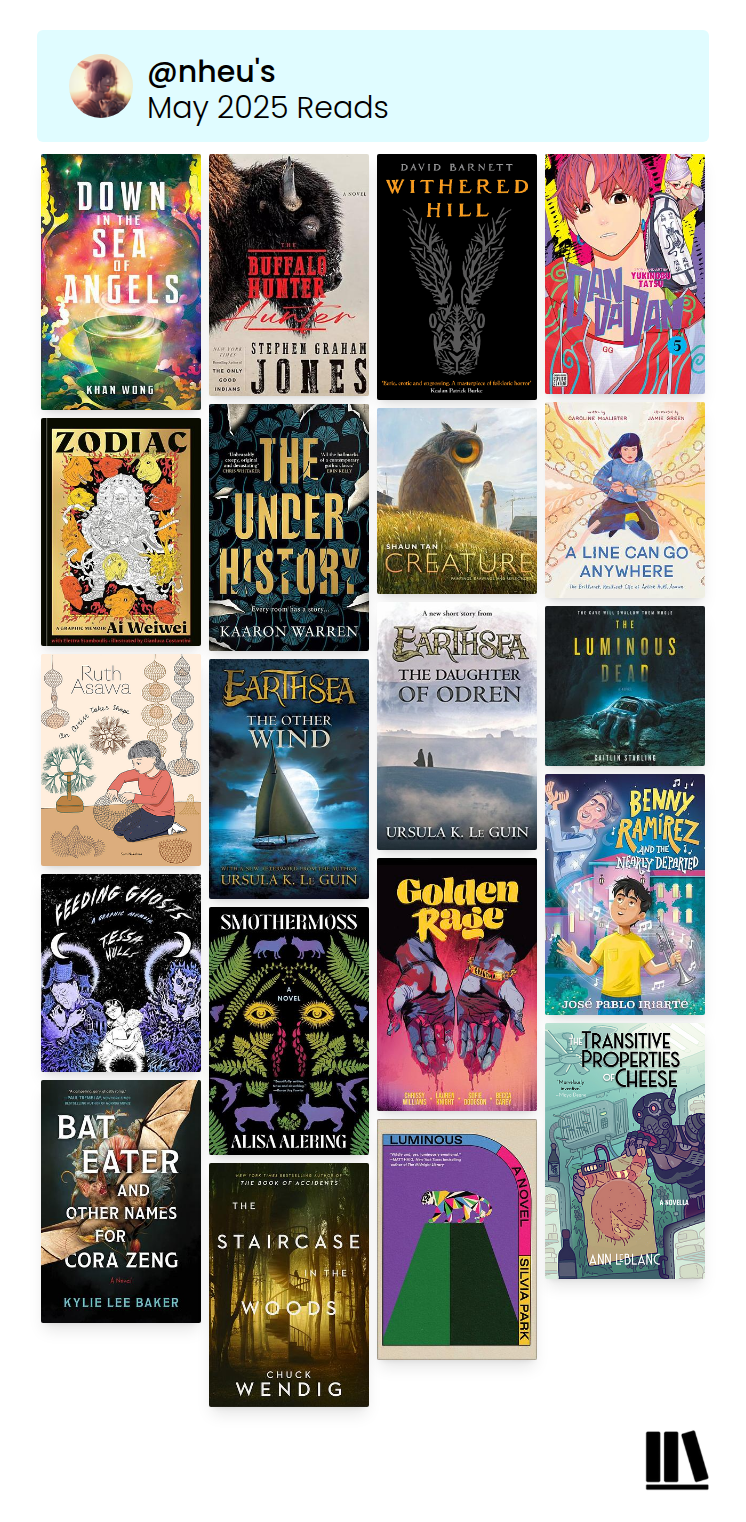Nheulandia
Blog Import in Progress Here
Check back soon for actual organization and things like that. This is a rough import from a WordPress XML. It has a bunch of fragmented unpublished stuff, and a bunch of stuff is somehow out of order? I'm guessing it's a proprietary thing. Blech. Anyhoo. Eventually I'll have it cleaned up.
Adventures in Reviewland Fri, 13 Nov

2020 is certainly a year for the books, but for me, not one for books. One of my greatest frustrations this year as a bookseller has been a lack of time or energy for reading and reviewing books. Real life was hard, somehow reading was also hard.
One of the perks of being a book buyer is ARCs, or Advanced Reader's Copies. They tend to slowly collect around booksellers, like dust woolies. I'm half convinced they breed in the dark. Because I have tons of them. Absolutely oodles. That image to the left is not my bookshelves, but somedays it feels like it could be.
One of my plans this fall is to dive back in, see what I can discover. Most of what I'll be reading will be books for children and young adults - young readers' literature is a passion of mine, and has been a professional focus. Not all of it will be, however. I have a few books I'm reading now - you're welcome to check out my Goodreads to see what I have on the burner currently, but my next book will come from these stacks. I think I'm going to just start with what's on my rolling cart (I have one of those, too, also full of books.) and on my bookshelf, and use a RNG to pick my next book, counting from the top left of my main to read bookshelf. I might just call this whole project "RNG Reviews." ^_^ What do you think?
I also have a lot of F&Gs to catch up on - Fold and Gathers. These are picture books that have not been bound, but do contain finished art or mostly finished art. I was thinking I could do those too, on Fridays as I can. Since I'm coming up with corny names - "F&G Fridays" sounds good to me. (Side note - I once got accused of being profane when talking about F&Gs. Interesting conversation, for sure. XD)
Review - Empire of Wild Sat, 21 Nov
EMPIRE OF WILD
Cherie Dimaline
A First Nation's Rogarou tale of lost love and salvation.
(CWs below)
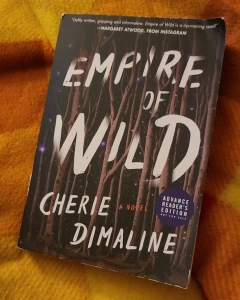
You know, I wish I had picked a different title to start with here. I read Cherie Dimaline's Empire of Wild over the course of several months. That ARC *lived* in my backpack, just waiting to be picked up again. It took a while. To be honest, I struggled with reading for much of the lockdown, and after it, just because I was too overworked to think much outside of what's for dinner, and what thing do I need to do next for the kids or pets or house.
Anyway, once I got back into it, this was a quick read, and one I've thought about extensively. I think if I had been reading this book outside of a writer's perspective, I would have enjoyed it more. It's a good story, and it addresses a lot of First Nations issues head on - struggles with racism, pressures for development, and balancing tradition with the need to provide, for starters. It is woman-centered, and as Dimaline says, the women have agency and authority in their lives. This is to be celebrated.
On the other hand, a lot of that agency seems focused on sex. Actually, most of the adult characters - male and female - are focused on sex. It's a frequently recalled or longed for activity, and I think while it is a driving force of the story, it does little more than providing character motivation, avoiding any serious thematic exploration of desire or power. And as such, I think it distracted from the story.
There are points of great luminosity in the prose itself. Sometimes the book just sings along, painting bright images, places and scenes you feel you could almost immerse yourself in. Other times, however, the book is very self conscious, and I think it ultimately loses itself to this along the way. The plot and character development seem a little perfunctory, and the ending is not a great challenge to predict. Perhaps this is borne out of the author's previous work in YA, but regardless, I found the story slipping away from me, and the ending a little pat and abrupt, its resolution emotionally detached. On a personal level, I found the ending particularly frustrating - [mild spoiler alert] - that perhaps the betrayal was not the youth's, but his mother's - an idea alluded to by the author herself earlier in the text.
Dimaline is a "young author" and you can see that in her prose, where it falters. She sets a good story, however, and I wouldn't mind reading another book by her in the future.
CW - animal abuse, parental abandonment, drug use, alcohol use, violence
11-29 Review - Untamed
UNTAMED
Glennon Doyle
Great thoughts couched in personal narrative.
It's hard for me to separate how I feel about Untamed as a reviewer and how I feel about its place in my life. I picked it up at just the right time, when life was swirling into a deep eddy of chaos and uncertainty. I needed help, and there are gems of wisdom in Untamed, without question. Sometimes Glennon Doyle's words helped.
The format of the book is perfect if you're low on time - brief anecdotes chained together to make a certain point, or intended (I believe) to lead to certain kinds of reflection. And that's really central to the book's strength - bite-sized, sparkling thoughts to get you moving forward on doing your own work, on your own self, on your own mind. Doyle is supremely quotable. A quick search on Pinterest will net you hundreds of quotes, often lovingly calligraphed. Those quotes can be a lifeline to some who are searching. Occasionally, they end up in my journal, as they can be the perfect reminder of another, better way to be.
Roxane Gay reviewed this book on Goodreads, simply stating "I'm not the target audience for this book, but I am glad she found her path and a loving partner." I get that. I'm not her audience, either. I'm not from a comfortable background, my struggles leave me closer to the bottom than hers, and that's no judgement of her or self-aggrandizement of myself. I was also raised a secular humanist, and her background is in Christian self-help.
She and I both share privilege - we are both white women - but, frankly, I have a lot less. There's an ease that some folks in the self-help business have that speaks to a lack of devastation. You can tell they've not really seen poverty, really seen violence or the protracted chaos of underserved mental and physical health needs. Glennon Doyle has this. I'm not knocking her struggle - we all have them, and our struggles are unique to ourselves. We shouldn't compare. Sometimes, however, she just leans into middle/upper class WASP, and she cannot, for the life of her, REALLY see it, at least not in the narrative she uses to describe her life. To be fair, she does acknowledge her own privilege in the course of writing this book, but she doesn't ever follow through on it. At least in the scope of this book, she doesn't really get into the meat of why her perspective might have deep limitations.

Photo by mali maeder on Pexels.comWhen you read reviews for Untamed on Goodreads, many of them excoriate Doyle. A lot of them point to this blind privilege to discount the book as sanctimonious, but I think they, too miss the point. At its best, Untamed is an open exploration of one woman's struggle. One response to Ms. Gay's review suggested the book was for the Lululemon set, and I think there is truth to this, but at the same time, it's not the whole truth. Doyle recounts finding her place in the sun by letting go of that need that we - especially women - have to judge or be receptive of judging. By deciding to just be who she is, she's stepped away from the role she's expected to play. She's stepped free of the game, and at her best, her writing encourages others to do so as well.
So while Untamed might not be on my "favorites shelf" for the year, it's earned it's place as a recommendation. There's peace to be found in her words, if you're path approaches hers.
cjhonaker commented: 2020-12-01 17:33:18 2020-12-01 17:33:18 I have been thinking of picking this up, but have the same thoughts about not being a book for me. Thank you for your honest thoughts- so many in my circle deify her, and I am not going to say some of the things she says are not inspirational, but some just don't fit with my experience.
Review - The Starless Sea Sun, 21 Feb
THE STARLESS SEA
Erin Morgenstern
Beautifully imperfect story about Story.
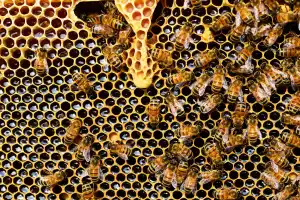
I've had this ARC for more a year and a half. I was really looking forward to reading it. A coworker passed me her copy, but she's super hardcore about her book usage, and what I got was in 7 pieces. (ARCs are frequently not high quality bindups.) I did my best, but you can't really take a book like that everywhere, as I'm wont to do with ARCs. So I set it aside. Then 2020 happened.
I picked it up again in the fall of 2020, and once I got going with it again, it was a super fast read. The narrative contains multiple stories that wrap around each other, leaving clues and puzzles that won't make sense for large portions of the novel. The main character is sweet, and unassuming, and the story that wraps around him is romantic and lush. The world he walks through is well-envisioned and a delight to the minds eye. Each supporting character also has a thread, but they are all less well-envisioned. They make sense, and by the end all has been made clear, but some of the motivations of the characters seem tentatively named and explored.
I've been working on a review for this book for way too long. Time to move on, I think, rather than continue to try and sort out my thoughts on it. Starless is a good book - very interesting, especially if you have a love of storytelling, chock full of symbols and references. There's a lot packed into the book, and I think it suffers for this a little bit. Story is universal, but trying to stuff in such a myriad of perspectives and ideas weakens the overall effect of the book, which is a shame.
A Tale of Two Podcasts, or How Two Stories Kept Me Sane on a Difficult Road Sat, 03 Apr
I've recently had to travel for some of those grown up reasons you might know of when you're a child, but that end eras for adults. Probably a maudlin and overly wordy way to put it, but I suspect, if you're reading this, you're old enough to to know what I mean.
Anyway, I rented a car and drove north from here, passing through Alabama, Tennessee, up to the north and east. I passed places I've lived, places my parents lived, places I've visited, the places where my dad's extended family is from. I drove on my own, and pressed myself to make the journey as quickly as possible. To keep myself company I pulled up a podcast I'd been meaning to try - Old Gods of Appalachia, a "...a horror-anthology podcast set in the shadows of an Alternate Appalachia, a place where digging too deep into the mines was just the first mistake."
I started out in the early afternoon, so as I reached northeast Alabama, the day was done. And y'all, I was spooked. What had started out as a necessary quest to find my future had turned into a look into my past. All the places I was passing, all the touchstones ... couple that with the shroud of darkness, mountains like behemoths, rising as voids along the horizon, trees grown thick about me ... well, let's just say I was transported, beyond just the physical. My trip began to feel less practical and matter of fact and more a move between worlds.
Old Gods was started right before the Pandemic. Their first season is polished and obviously thought out ahead, at least at the beginning. Part the way through that first season, the our real life Great Sickness hits - you hear about it in the intros and outros. Obviously Covid affected their plans, but it also brought a new layer of dark awareness to their stories. Maybe it's a terrible thing to say, but the tragedy and sadness of 2020 brought a focus to their storytelling, added more grain and grit to the tales they were spinning.
I drove a long way with the characters of their tales, passing through the regions they were talking about, or at least where they might be if I was through the veil and driving through their dark vision of the Appalachian past. Their stories kept me company, kept me transfixed as I navigated.
I caught up with their tales just after I reached my destination, in the town my parents each last lived. That seemed right, somehow. I'm caught up now, waiting for their next episodes - we're on part three of season two, and "family," I can't wait to see where they go next.
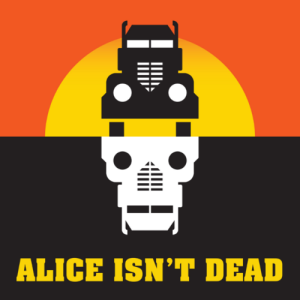
On the long road back I listened to a now finished podcast I'd also been meaning to catch up with - Alice Isn't Dead. Summer before last, before the world went Topsy-Turvy, I read the Alice Isn't Dead novel - a complete reimagining of the podcast by the same author, Joseph Fink. Fink is one of the creators of the Welcome to Nightvale podcast - wildly popular amongst Certain People I Might Consider Kindred, and yet another thing I've yet to dive into. Life's hard, y'all.
The mood of Alice is completely different, although it also deals with the underbelly of the universe, and the various dark things that grow there. I won't spoil anything, but the villains of the story, while similar in tone to the Old Gods baddies, have a very, very different origin. (All I'm going to say on the matter. Interested - stream the podcast! ^_^)
Both podcasts have good sound production. Old Gods is subtler, sneaking up on you, scaring the pants off of you, contextually. Suddenly that monster of the woods is in the room with you, sharing its mood, and family, it's not feeling forgiving. The sound in Alice is a lot more heavy handed. The main character is Keisha, who's taken up truck driving cross country while searching for her not-dead spouse. You follow her as she recounts her journey across trucker radio airwaves, and sometimes her world encroaches on your own. More than once I jumped when driving, startled by the sound of a blaring horn or other car related noise. Probably not the best choice for a solitary driver, but I was motivated, y'all.
Alice spans 53 episodes, covering just enough time for me to drive all the way back to my home from where I was. 53 episodes, come to find out, will get you about 2000 miles down the road. I chose it in keeping with my journey - while markedly different than Old Gods - it's more contemporary, less gothic, more cynical - it had some similar elements of "being afloat" and "being different". And it was basically one big road trip, which suited me just fine, as well.
Comparing the two IPs is not really an easy thing to do. Old Gods brought me home, in a lot of ways, sharing stories of family, fear, the dark unknown. It's centered in a part of the world my ancestors all called home, and its vernacular is familiar, easy to access. When you add elements of gothic horror and Lovecraftian mayhem - well, just consider me sold. I'm a lifelong fan now.
I loved the Alice story, although it was a little harder to navigate. The main character is sympathetic - I totally get her anxieties, and to be honest I've secretly always wanted to be a long-haul trucker. It's an interesting tale, if a bit diffuse. The story's good, but the ending is a bit vague. I loved it, don't get me wrong, and I understand that Good Stories Leave Questions, but I wish Praxis had been better addressed. It seemed written on the fly, with less constraints on the story universe. More poppy, less focused.
Both podcasts deserve their popularity and adoration, and if you're interested in a good horror podcast, both would fit the bill. I highly recommend you check them out. They both have awesome merch, as well - check out Old Gods' here, and Alice's here. Old Gods has a very active Discord server, if you're looking to find like minds. I've just started investigating it, but it seems like a good safe space filled with interesting people.
Ultimately, I'm most grateful to have found Old Gods of Appalachia. It will be good to have their company in the long days ahead. And honestly, y'all, I'm looking at more than just a few.
Be well, friends.
Review - Bitter & Pet Sun, 30 Apr
BITTER
Akwaeke Emezi
Satisfying Quick Read Prequel
(CWs below)
Hope is a discipline. -- Aloe

I've had Bitter for quite some time, living on my chest of drawers since last Independent Bookstore Day, as a matter of fact. I read Pet a few years ago, pre-pandemic and was quite taken with it. It is a breathtaking book, and I remember how excited I was to hand-sell it when it came out, but the details had faded somewhat, with everything that had come and gone since then.
I've struggled with reading much, in the past few years. There are reasons that make sense, but they don't belong in this book review, so let's pass them by with just that acknowledgement. Don't get me wrong, I love books (especially YA and children's literature) and writing and creativity, and reading can be a real joy. To be swept up in a story is a treasure, a sweet taste, a moment of other. I've missed it, honestly.
Recently I picked up a book (review soon) that I had been working on finishing, slowly, one that I started before the pandemic but had just ... struggled to move forward with. I think giving myself the space to *not read* for a while has been good, because I found it much easier to dip back into the author's world and follow the characters on their journey. Once I got back into it I fairly zoomed along, which is what I used to do. Speed reading comes in quite handy as a bookseller. Anyway, once I finished that book, I was still hungry for more story, so I picked up Bitter, excited to see how it went as I'd really loved Pet.
What I found was enveloping and genuine. The story was linear in the same way Pet was, but softer, moving forward in little ripples, at least at the start. Bitter and her friends, her beloved and the people she respects, they hold space for each other and, even if they grow angry, they are careful to argue safely, and to apologize when they need to. I've only read these two books by Emezi, but that is one of the things I treasure most about their books - that their characters in these books respect one another and properly take care with their relationships, working through difficulties when they are called out for not doing that well.
The edges of Lucille are blurred and unreal - meant, I think, to also stand in as an avatar for our real, more complicated world. The struggle of the people in this world are very real, and very real consequences are met, but at the same time, Lucille is able to stand on its own, and its people make decisions on their own, free of the interconnected consequences of our world.
Bitter is a great read, but more *just* a great read, and a wonderful companion to Pet. The latter book is thinner and tighter, focused well into the future of Lucille. I've borrowed Pet from the library and reread it so that I can write this review.
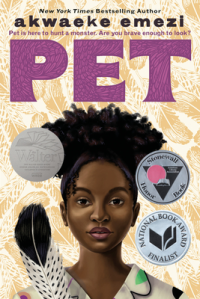
PET
Akwaeke Emezi
Lightfilled and Compassionate. Fast, Gorgeous Read
(CWs Below)
Pet is definitely best read first, in my opinion. The world is concise but faded into the background, seen through the eyes of a wonderful main character. Jam is a young trans girl, perhaps around twelve. She is the daughter of Bitter and Aloe - a painter and paramedic, respectively. The story introduces us to Jam and her world on the last day of school for the summer. We meet her best friend Redemption, we see her mother's art practice and learn a little bit about what she is painting. We meet the librarian (Ube), learn more about Lucille and its angels. We learn about Jam herself - how she chooses to sign when she needs - how she is nonverbal much of the time. And then an accident happens, and we meet Pet, summoned to Lucille to hunt for a monster, a monster that the adults in Jam's life swear can't be there.
Pet is a tight, fast-paced read, and it is slim, so I won't spoil any more of the plot, barring the content warnings below. It moves rapidly towards its conclusion and while characters are loving and well-communicating, and most of Jam's world is a safe space, the dangers that Pet hunts for are all too real. This is a gorgeous, triumphant read. It is full of luminous hope. It was a precious thing to follow Jam and Redemption as they moved into hard tasks and in doing so, made their world a better place. Highly recommended!
My one caveat regarding Bitter is this. Knowing that it was written after Pet, and knowing what I do about the characters in each story, I'm a bit surprised at how gently and kindly drawn one character is - one that we meet in Pet and return to in Bitter. If you have read both books, I'd be interested in your take on that - I'm sure you know which character I mean. Having the life experiences I've had, I'm a bit ... unsure I would have drawn that character as compassionately as they are drawn in Bitter. Perhaps that is my failing. Regardless, lots to consider.
If you've not read these two books, please consider them. Especially Pet, my favorite of Emezi's books so far.
CW for Bitter – discussion of parental abandonment and abuse, parental death, drug use, violence, death
CW for Pet - violence, abuse
Review - The Hidden Palace Thu, 04 May
THE HIDDEN PALACE: A NOVEL OF THE GOLEM AND THE JINNI
Helene Wecker
Satisfying Product of 2020
(CWs Below)
So I've finally gotten around to sorting out the Libby app for my county's library system and WOW was I missing out. I've moved from a smaller town to one of the country's largest and the differences in terms of available resources are mindblowing. Unless you are looking for a job. Then this new town is awful. Super hard to find anything, even fast food jobs. But I digress....Anyway, let's talk books! I have been having a grand old time digging through what's available.
I was rooting around in the virtual stacks and saw The Hidden Palace, a book I'd literally forgotten about. This is a sequel of sorts to The Golem and the Jinni, a book I remember loving, but it was pre-Pandemic, you know, and I'd forgotten a lot of the details. Luckily Helene Wecker is pretty good about weaving in background as this new story needs it, so you can really dip into this newer book as a standalone, I think.
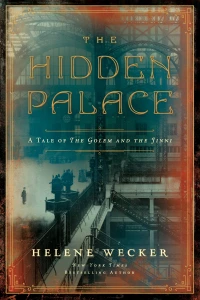
Once again, Wecker weaves Arabic and Jewish stories and world views. There are many points of view in this book (were there so many character viewpoints in the previous title?), and I was a little worried about that at the beginning - it can be a bit distracting. Perhaps the first third of the book is dedicated to a slow-burning setup, but its a richly drawn world and I didn't find myself minding. Once the plot starts connecting dots everything moves rapidly closer, drawing to a fairly satisfying conclusion. Not (to my mind) perfectly landed - there are a few threads that don't really get woven back in perfectly - but nicely done, regardless. No spoilers, tho. Feel free to drop me a line if you want those.
This book was a treat to read. A lot has happened since I read its predecessor, and I feel like the follow up is a little less deeply drawn and thought out, but it's not a first book, and, interestingly, I found out after the fact that it was written during the lockdown parts of 2020. Knowing that and looking back, I can see overarching themes of isolation and loneliness in this story, echoed again and again throughout the character arcs.
Life is going to keep me from writing a more in-depth review this week. If you have questions, drop me a comment or an email, and I'll be happy to answer them, to the best of my ability. My main takeaway - The Hidden Palace is a satisfying historical fiction, chock full of magical realism. I recommend it!
CW - intimated child abuse, partner violence; some moments of violent fighting, death
Review - The Sullivan Sisters Wed, 10 May
THE SULLIVAN SISTERS
Kathryn Ormsbee
Better Than I Initially Expected
(CWs Below)
Here's a title I've held onto for ages. I started it, and it was edging towards a DNF (Did Not Finish), but something about it made me want to keep going. I've been considering what that might be in the time between finishing this book and writing this review. I think that it comes down to the genuineness of the journey of these sisters. There are aspects of all three sisters that I deeply identify with, and I get the mom's experience too. (Single Moms Unite...) Regardless, I struggled to really get moving on this book. Here are my thoughts on why, and why it may still be a good book for you to pick up.
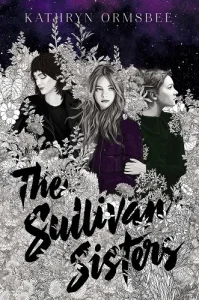
One thing I noticed in my years of bookselling is this propensity of publishers to swing to extremes on covers, especially on YA novels. Either the cover is fabulous, hip, and on point, or it's ... not. And the amount of NOT actively undermines the salability of the book. It's hard to handsell a book with a bad cover. It just is. (Looking at you, movie tie-in covers - you're not the hot stock you think you are. <.<) The Sullivan Sisters has the latter kind of cover. In this case, it's not a bad image, at all. It just feels out of place - for whatever it's worth, I was reminded of book covers like that of Flowers in the Attic. It's also got nothing to do with the characters, really. It's hard to pick out who's who - I assume that Eileen is on the left in the stereotypical leather jacket, Claire in the stereotypical blond moment in the middle, and Murphy off on the right with her hair up and in the dark coat. Murphy is fourteen in the story, by the way.
Again, it's not a bad image, but it is enticing to an audience that will probably not be well served by the story. It's not dramatic romance, or high family drama, or the like. (Sarah Dessen comes to mind.) It's a serious story, with serious issues plaguing the family as a whole. As a consequence, I don't believe this story is for everyone. Frankly, I wonder at the story's accessibility for young adult readers who have not "been there."
The beginning of the story was a little rocky for me. There is a formative event, and then we are moved into the present day. Each sister is struggling with their lives in a different way, and none of them, to me, were really very compelling. I'll avoid any plot spoilers, but something dramatic happens and the three girls are thrust into a new environment for the rest of the book. At that point the story begins to cook with more gas, and we move through each of the sisters minds as the book progresses, learning about their struggles and thought processes. Claire is trying to be a go-getter, and is smitten with the catch-phrase laden culture created by an influencer. Life throws her a major curve-ball, and she's angry and hurt - things are not going to plan. Eileen has inadvertently learned what she feels is a dire family secret and suppresses how deeply this has affected her with alcohol. Murphy is the youngest - fourteen - and struggles with feeling invisible. From my perspective, it seems she is struggling with a little OCD and dissociation, but that's my off the cuff read of serious issues, and may further be colored by my own life experiences. They are alone in their current predicament - set in a modern day at Christmas because their single mom is off on a cruise won in a raffle.
Perhaps it is the mom's role in the book that was such a struggle for me. She leaves the girls at Christmas, and she has withdrawn from life so much that she fails to see the mental state of her children...I'm sure that sort of thing happens, but it just bothered me. Could she really not see these issues or did her lack of involvement merely stem from her own mental health struggles?
The story has a few plot elements that are a bit smooth and fantastical for my cynical self to find believable, but it's a YA book, and I'm glad they are there. On the other hand, I also love that Ormsbee handles the seriousness of each character's issue well, to my way of thinking - with compassion and realism. All these issues and the related events in this family's lives have consequence, but there is still sunshine to be found at the end of the book, and that brought me joy.
So, ultimately, I am glad I read this book and recommend it, but with some caveats. It may be a slow start for you. And there are a lot of serious things discussed in these books, so please take care if any of these content warnings (see below) are an issue.
Content Warnings - alcoholism, drunk driving, murder, loss of a parent, poverty, bodily injury, discussions of eating/lack of eating
Review - Liberation Day Mon, 15 May
LIBERATION DAY
George Saunders
Saunders is always a liminal kick in the pants...
(CWs Below)
I don't know if you've read any of George Saunders's books, but they are always a challenge. And I don't mean like get your steps in for the week challenging, I mean brain-sweating, intellect-chewing "I'm going to be thinking about this for ages" challenging.
I haven't read all of Saunders work. First thing I read was Civilwarland in Bad Decline, which is a brilliant, dense, satirical collection of stories lampooning America and Americana. Saunders has a deeply original voice, with stories that challenge (there's that word again...) the reader with structure, characterization and content. Sometimes/frequently all at once.
Saunders teaches writing at Syracuse University, and if you look him up on YouTube you can find a slew of interesting interviews and even a really great series about story by Redglass Pictures. The latter better just searched for as the channel does not show all of the videos. I'll embed one below so y'all can check it out. They're introductory, but I've thought about these videos again and again over the years. Neatly done little things.
Anyway, I am deeply interested in anything Saunders has to say about story, and when life settles out a bit more, look forward to reading A Swim in a Pond in the Rain: In Which Four Russians Give a Master Class on Writing, Reading, and Life. I think, like King's On Writing, there's going to be some meandering, but just like with some of my favorite writing classes (looking at you, John Dufresne), that's where the ... more ephemeral grist for the mill is. I'll let y'all know when I get it read, but if any of you have read it, I'd love to hear some feedback.
I was recently able to borrow Liberation Day, his first collection since Lincoln in the Bardo, one of my favorite books. I knew it was going to be challenging, having read other short works of his prior to Lincoln, and it was. This volume contains nine stories, starting off with the longest, which lends its name to the book.
Looking over reviews of this collection, it seems a lot of folks view it as uneven in focus and, in some instances, quality, but for the most part I think that perspective might originate in the reviewers love of Lincoln in the Bardo, Saunder's singular novel. Frequently, I found that more negative reviews of Liberation Day were comparing the two, which is definitely literary fruit comparison. This is an orange that feels, in my incomplete experience, like a very George Saunders Orange.
Saunders says this about the arc of this collection: "In each of the stories in Liberation Day, someone starts out deluded and confused and misled, then sheds that delusion and moves in the direction of truth, with different results." I could see that, myself, as I reached the end of these stories. Most of them are fantastical, short of two of them with a more realist bent. They all are drenched in Saunders's very unique voice, but also they are threaded through with a quiet compassion that I really love. Not everything goes well for his characters, but he treats them with respect, and in doing so gives the reader a great deal to think about. While this was a difficult collection for me - some stories definitely take a lot more focused effort to get into and through, I really enjoyed it. The compassionate, frank journey one takes with each story's main characters is well worth the effort, in my opinion.
(As with all of Saunders's work, diving into this collection means abiding with a lot violence and cruelty. If you dig in, be prepared for that. You can see some content warnings below.)
Resources for more on this book and George Saunders:
- The weird and brilliant stories of George Saunders from Think at KERA
- I really enjoyed this interview at BookForum Magazine.
- A bit after 19 minutes into this episode of Wait Wait ... Don't Tell Me! there's a brief interview with George Saunders here before a game. Not super on point, but in some ways...very on point...maybe? Anyway, it's fun.
- I'm slowly working my way through this tangentially related journal article: "Haunting and Satire in the Short Fiction of George Saunders" by Amélie Moisy.
Content Warnings - domestic violence, violent death and murder, slavery, child abuse, death
...art is a way of infusing your days with a relation to mystery.
-- George Saunders
Review - The Annual Migration of Clouds Thu, 18 May
THE ANNUAL MIGRATION OF CLOUDS
Premee Mohamed
Tense, Pared Down "Cli-Fi"
(CWs Below)
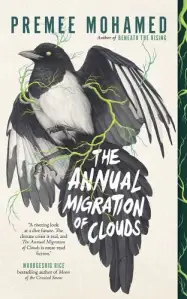
Author's Note - Y'all, I had a hard time getting this review written, for whatever its worth. Apologies if it starts out a little unwieldy.
The world is changing, twisting into a shape unrecognizable. There are many authors stepping into that unknown and exploring what it means to live in a broken-down, drastically changing/changed environment and community. The Annual Migration of Clouds is the first work of Premee Mohamed that I've had a chance to read, probably among the best I've read in "Cli-Fi."
Cli-Fi is a pretty loaded term. Climate fiction, as the name implies, is fiction that centers on the great changes occurring in our climate, and illustrates a world in which a story's main characters interacts with those changes, frequently with a scientific and/or speculative perspective. (See this Wikipedia article for more.)
Jeff VanderMeer - a writer whose work immediately springs to mind when I think of fiction that grapples with climate change - wrote a really good article that unpacks a lot of the problems with both the term and topic. Setting aside the issue of the origins and usefulness of the actual terms, VanderMeer writes: 'Even without this unnecessary human melodrama...there lies a problem of domain and dominion—both who gatekeeps the entrypoints and how we get to write about our current precarious position. “Cli-fi” is often interpreted to be a subset of “sci-fi,” and thus it’s expected to contain a speculative element. Yet, in this moment, cocooned uncomfortably within climate crisis, as if trapped within a porcupine turned inside out, the issue is not speculative. It permeates everything and everyone, even those who have not recognized it yet. Poetry, contemporary realist fiction, interdisciplinary art installations—any creative form, in any mode, can (and sometimes should) engage with the climate crisis, even if it’s just a persistent hum in the backdrop, like a misfiring bank of fluorescent lights.'
I think it's interesting to consider his argument for fiction as a whole - both the role of the fiction writer in the effort to affect climate change and the appropriateness of considering them liable for that. In this case, I haven't found anything that gives me a lot of insight into Mohamed's motivation in writing this story, but I really enjoyed it, and appreciated its setting - imagined in the post apocalyptic ruins of the University of Alberta. I've seen it termed Cli-Fi, but I think that the crux of the story is more centered on issues of truth, loyalty and self-determination. The book's publisher refers to it as hopepunk, and to me that's a better fit than just Cli-Fi in general.
This is an unflinching, violent story, told in lean, gorgeous prose. The main character does not shy away from hard issues both within and without, but there is compassion in that telling. I don't want to speak much to the plot as I think it could easily be a spoiler (not a lot of wiggle room with a thin novella), but there's hope and possibility in the conclusion, even in light of the hard environmental difficulties that serve as background to it.
Content Warnings - death, loss of a parent, loss of a friend, illness, violence, hunting, animal death, dismemberment, suicide and suicidal ideation, possibly some aspects of abusive relationships
Quick Review - The Drift Sun, 21 May
THE DRIFT
C.J. Tudor
Flawed but Fast Apocalyptic Thriller
(CWs Below)
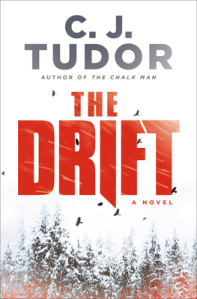
Recognizing I've posted a lot in a little bit of time, and a lot of book reviews at that, I'm just gonna make this one quick. This is my first CJ Tudor novel, and my first thriller in absolutely ages. I tend to shy away from them because I just zoom through them, and there's only so much time to read. There's absolutely nothing wrong with a thriller, but to me, personally, they feel like literary empty calories.
Anyway, I read The Drift recently, as it was on an Esquire magazine list of The 13 Best Horror Books of 2023. As I had quick access to it via my Libby App, I decided to download it and give it a try. It's fine. There are three timelines with three main characters. Eventually these timelines intersect. Some of the connections were interesting and clever, other's involved quick tricks with hidden information. It's fast paced and for the most part it kept me engaged, although there were a few plot points that were far fetched. I would not, however, term it horror. I may be in a minority in this, but (small spoiler here) I don't think zombie stories at this point are necessarily horror, even-post-apocalyptic ones. This was ... just a thriller. Does that make sense? I think if it qualifies as "horror" writing, per se, it's body horror most of all, although a mild version of it.
Content Warnings - violent death, blood and gore, mutilation, death, vehicular crashes, falling from heights, gun violence, emotional and verbal abuse, dead bodies
Quick Review - Nona the Ninth Mon, 22 May
NONA THE NINTH
Tamsyn Muir
Big Thick Book of I Don't Know
(CWs Below)
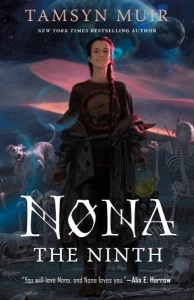
Meh.
I do like Muir's writing. Gideon the Ninth is a romp, Harrow the Ninth starts out confusing but is also a romp - containing the best revenge killing ever, really - while at the same time being a study in deep grief.
Nona the Ninth is also confusing. It's a good read, fun, lots of jokes, but the story really does not get rocking until two thirds of the way through and this is a LONG book. In the same exasperating way you can't really step into a Marvel universe movie without having seen a bunch of others, you're going to do yourself a great disservice if this is the first of The Locked Tomb books you've read. I've read all of them, but I did not go back and reread the first two before reading Nona, and that was a big mistake. I struggled to recall things that Muir takes for granted that you'd remember, so there are lots of cameos and callouts I missed out on. Also, while I appreciate Muir's gothic, heady, backwards first writing style, the end lacked a great deal of emotional punch, mostly because I am not an uber fan totally up on my Locked Tomb mythos. Even if you've read all of the books and remember All the Things, I suspect the ending might be a bit of a flat landing for you. At least it was for me.
I did a a bit of research on this book, and I know that Nona wasn't planned - that it was an extra book that contains the first arc of what was supposed to be included in the upcoming Alecto the Ninth. I was very unsurprised to read that. The plotting in the book struggles from a lack of tight finesse, and while it's interesting, I feel that it came to publication as it is - an unplanned title - because the publisher knew it would sell. I pretty much agree with this review at Gizmodo. Nona is a whole lot of missed opportunity.
Content Warnings - death, blood, dismemberment, violence, war
Review -- The Library of the Unwritten Mon, 10 Jul
THE LIBRARY OF THE UNWRITTEN
A.J. Hackwith
Great worldbuilding, but I more look forward to seeing what happens next....
(CWs Below)

If there's one thing I love, it's a story about stories. The Library of the Unwritten is a nice mouthful of a book, deliciously thick with books and bindings and inspiration and reading. It's a sprawling first book of a new series, introducing its reader to a lot of world-building and new characters. There's a lovely spread of representation in those characters, both in terms of romantic interests and just physicality. It's a lovely, uncomplicated read, in a lot of ways - even though the premise wants to belie that. From the description:
Many years ago, Claire was named Head Librarian of the Unwritten Wing-- a neutral space in Hell where all the stories unfinished by their authors reside. Her job consists mainly of repairing and organizing books, but also of keeping an eye on restless stories that risk materializing as characters and escaping the library. When a Hero escapes from his book and goes in search of his author, Claire must track and capture him with the help of former muse and current assistant Brevity and nervous demon courier Leto. But what should have been a simple retrieval goes horrifyingly wrong when the terrifyingly angelic Ramiel attacks them, convinced that they hold the Devil's Bible. The text of the Devil's Bible is a powerful weapon in the power struggle between Heaven and Hell, so it falls to the librarians to find a book with the power to reshape the boundaries between Heaven, Hell....and Earth.
I've read a few quick reviews that call this book out on a slightly loosey goosey plotting, and I'd agree with that. The book wanders to and fro, but it's a - dare I say it - cozy wander, even in the face of demons and betrayal. There are richly written locations inside these pages, and those were what I loved best. Couple that with most characters wanting to do their best - flawed or not - and you have a comfortable, good read.
While it wasn't a page turner, The Library of the Unwritten was a satisfying read, one I could turn to in the space of my long and unwieldy days. There are books and heroes and great battles and angels and muses and lost loves. Stories literally come to life inside this book, and I think if you love storytelling and stories and grand adventures, you'll probably like this.
Postscript -- If you are looking for something toothier and more obscure - might I recommend The Starless Sea?
Content Warnings - death, blood, violence, alcohol consumption
Review -- How To Sell A Haunted House Thu, 13 Jul
HOW TO SELL A HAUNTED HOUSE
Grady Hendrix
Old School Creep, Lots of Triggers
(CWs Below)
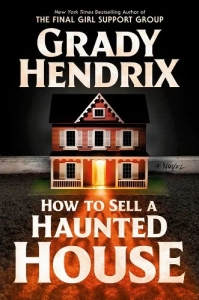
Welp, this was a messy read for me. I don't know if you have read any Grady Hendrix, but he specializes in quirky horror, often written in a way that is evocative of 80s horror writing. How to Sell a Haunted House is one such title. I got this book read, and it was fine enough, but it was deeply triggering, and not for the reasons you're probably expecting.
Admittedly it's been a while since I've read any classic 80s horror, but I don't remember any of them having such a deep feel for family dynamics. Maybe that's because I was young when I was reading them, and life had fewer layers of complication. Regardless, this book is just burgeoning with family trauma and complicated, unhealthy relationships. And it is set after the shocking and unexpected death of both of the main character's parents. The reader quickly finds themselves mired in difficult mother-daughter relationship issues, coupled with even deeper issues with the main character's sibling.
It's quickly evident, if you've had personal dealings with funerals and deaths and estates, that Hendrix probably comes to this story's conflicts pretty honestly - either through direct experience or by having seen it happen. It was frankly hard for me to read. If you've got family members that struggle with substance abuse and responsibility and family secrets and poor family communication, this might not be the book for you. I had to put this one down over and over again because it felt way too familiar.
Interestingly, I've seen reviews that suggest that these aspects are charming or Conroy-eqsque. I've read Conroy, but admittedly not recently. I once met him, and I knew his wife for a while, and nothing I remember meshes with this level of messy family - or rather this flavor. I think I might need to go back and reread some of Mr. Conroy's stories - because I just don't recall this much frustration. Maybe it's just down to the Low Country location most of the book takes place in? I'm not sure.
Anyway, shenanigans ensue, and the main character - Louise - struggles with her feelings about her parents' death and her sibling. She also struggles with the legacies her own parenting have left on her as she navigates teaching her own daughter about death. But this is under a fairly intense old school horror tale that begins to unpack itself pretty quickly. So you are dealing with Louise's love-hate relationship with her brother against a fairly constant background of scary happenings and personal endangerment.
If family triggers aren't a concern for you, you'll probably have fun with this one. It's got creepy dolls and taxidermy and puppets galore. The main Scary Thing is pretty good, and the story resolves itself pretty nicely, both from a horror story perspective and a family conflict perspective. I just don't think it's for everyone. Please take care, gentle reader.
Content Warnings - difficult family dynamics, children in mortal peril, death, drowning, blood, dismemberment, alcohol consumption, puppets, dolls, clowns
Review -- The Archive of the Forgotten Tue, 11 Jul
THE ARCHIVE OF THE FORGOTTEN
A.J. Hackwith
Continued Adventures with Hell's Library
(CWs Below)

So I found the sequel to The Library of the Unwritten on Libby and sort've checked it out and read it yesterday. o.O I'm gonna justify it because it was after dinner, mostly. Read until late. I will never not be grateful for being able to speed read.
Anyhoo, I was super glad to find the next book in the Hell's Library series. I found the first book wandering around my library app - I unfortunately wasn't aware of it beforehand. I was deeply curious how the writing would develop into the next book, and for the most part I'm happy to report this sequel is worth your time.
The writing is less tentative and the locations are still evocatively drawn. There's one character I figure folks will either love or hate, but that character fills a trope I've seen increase in popularity over the years, so I think most readers will love them. This is an interesting second novel in that it deepens the story - as it should - but it does so by allowing the characters to make mistakes and to wallow in bad takes and indecision. I enjoyed watching the characters struggle with themselves, their choices and their consequent environments. Hackwith treats her characters with love and respect while allowing them their rough edges. Plotting is still a little vaguer than I'd rather, but by the end of the story I was left anticipating the next book. Speaking of, if you are wondering, there's a delightful romance tucked into these pages. I won't spoil whose but I was pretty darn content with how it played out. I hope you are too.
(Apologies for the quick second post. I just figured I should write this out while the story is fresh. Also, I swear I have more thoughts than book reviews. I just seem to actual manage to get them written, which is something, at least. Creativity can be such a difficult thing to wrangle....)
Content Warnings – death, drowning, mortal peril, violence, stabbing
Review Times Two -- Faith: Taking Flight and Faith: Greater Heights Sat, 15 Jul
FAITH: TAKING FLIGHT and FAITH: GREATER HEIGHTS
Julie Murphy
Good ... ahem ... FAITH attempt, Uneven success
(CWs Below)
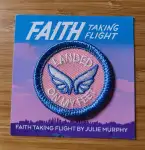
One of the upsides to being behind on some of my reading is there is often a sequel available when I finish part of a book series. I knew about Faith: Taking Flight when I was still an active bookseller; I have an ARC around here somewhere, I think. I have a little bit of merch from the book - specifically a patch - that I'm pretty fond of, for a lot of reasons. Having read the books now, I can certainly understand why the patch looks like a girl scout badge - Faith Hebert is earnest and tries hard to do right, and a patch like this just make sense for her personality.
If you aren't familiar with Faith Hebert, she is from the Harbinger comics by Valiant. I've not read the series, but I know of Faith Hebert and all of her fabulousness. Hopefully at some point I'll read them. Regardless, this duology by Julie Murphy represents a YA reboot of Faith.
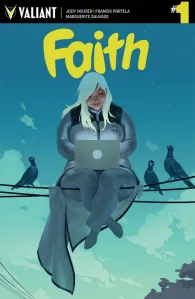
I've been aware of Faith's standalone comics (both limited and ongoing) since about 2016, when this lovely issue ended up on the shelves of my store:
I mean, what is not to love? Sadly, I've still not gotten the chance to catch up on her adventures, but hopefully soon. I love her earnestness and the loving way her series is made and written. She's a bit of a personal icon, really, if a bit abstracted at the moment.
I have a little bit of fangirl love for Julie Murphy, the author of this YA novel reboot. My HarperCollins rep dragged me to her lunch table at a book conference I attended, so I was able to meet her and share a meal with her. I was a children's and YA buyer for my store but I had completely missed that she was at that conference, so it was a bit of a jawdropping surprise to see her there. Bless Eric's heart - that's one of my better memories from that year. She was just as cool as you think she might be, and impeccably dressed, to boot. It made for a fun lunch with good conversation!
So I'd set aside this series as one to read in the future, something I was looking forward to reading, and I finally settled on reading it this week. Life's been interesting, and a YA superhero romp seemed like just the thing. I can read pretty quickly, so I had the first book read in short order, and dove right into its sequel Faith: Greater Heights the next day. I love being able to do that. Such a satisfying thing to scratch that "what happened next" itch pretty instantaneously. Libby can be such a godsend.
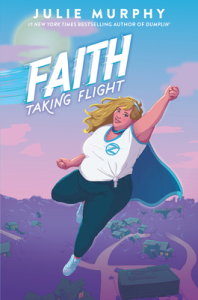
I won't cover a lot of the plot here - too easy to spoil it, I think. Here's the basics of the story, though. Faith ends up gaining superpowers the summer before her Senior year. She's not told anybody, and is still adjusting to them. She lives with her grandmother, having lost her parents at a young age. She has two best friends who don't know her secret. She's also a superfan of a TV show that her parents also loved, called The Grove, a show that has, for reasons unknown, moved its filming to her town.
A lot of both books cover normal high school worries about romance, classroom dynamics - just high school shenanigans and brouhaha in general. Faith is still trying to sort out growing up, and it is here that Julie Murphy does her best work in this duology. There is some good LGBTQIA representation here, and I appreciate that Faith is not claiming any one identity. She's just not sure who she is, as she feels attraction to both males and females. There's also a very honest and compelling storyline about her Grandma Lou that read very true to me. I am reluctant to mention what that is for spoiler reasons, but Faith has good cause to fear Lou's issues across both books. That isn't to say that it isn't dealt with appropriately, or that reconciliation isn't a part of that story arc, just that Faith's emotions rang true here.
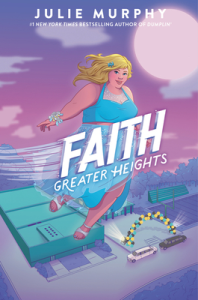
There are areas that Murphy really struggles with, however. There is uneven plotting and pacing in both books. A lot of stuff comes together at the end of the first book, which is great, but there are a lot of narrative threads that don't really read as compelling until the end. And it feels like she was trying to stuff a lot of Harbinger storyline into these books, sometimes without explanation. I think that could be confusing to readers who are not aware of the comic books. And there are turns to the second book that kind of ... push the boundaries of the believable.
I also take a bit of umbrage at some of the character behavior in both books. Characters generally ring true, especially Faith's two best friends, but sometimes their characters and others behave in ways I just don't think are healthy. I feel like Faith really needs to get into some counseling. Perhaps they are echoing what can be found in her comics, but either way, Faith has issues with clear communication, being manipulated, and taking blame that is not really hers. And that's just for starters.The main romance of the book is good, but again, there are aspects of it that seem a bit unhealthy? Perhaps that is my personal bias, but honestly, I don't think so. And since these books are YA, that concerns me a bit. Also, most of the significant interpersonal issues resolve a bit easily, and a bit unrealistically. I'm glad they do, but the feel-good wrapups, especially of the second book, are a bit lacking if you consider the issues in hand. They stretch believability here and there.
I wanted to like these books more, especially given our wonderful plus size heroine. And I love Julie Murphy for her contributions to plus size representation in YA and MG fiction. Unfortunately, both books are decidedly just OK. I'm a bit disappointed. They could have been so much more.
Content Warnings: Parental death, violence, loss of self agency, memory loss. Second book, specifically - fire, immolation, strangulation.

